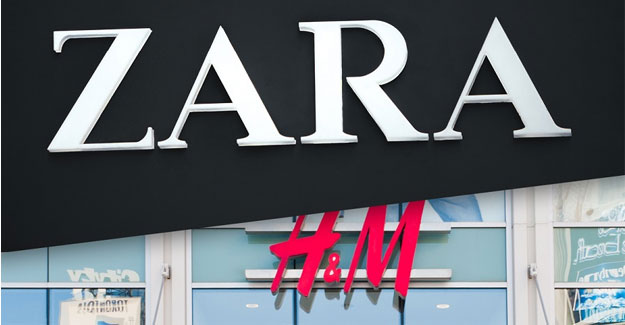
Zara Wins With The 4Es, H&M Loses With The 4Ps
Fast fashion is the darling of the fashion retail today. Whereas women's clothing store sales have declined 2.6% from 2016-2018 in the US, a recent report from Hitwise shows the fast fashion market has grown 21% worldwide over the past three years.
Two brands are the leaders in the fast-fashion market: H&M and Zara. Given that both are international brands, it's hard to draw line-by-line comparisons for the US/Americas' market. But here is what you need to know: Zara/Inditex is growing - 15.5% in 2018 on top of 15.6% in 2017 - whereas H&M sales declined 6.1% from 2017 to 2018. H&M operates 578 stores in the US, while Zara operates about 350 stores, plus 66 Zara Home stores. FIT Assistant Profession of Technology Shelley E. Kohan and I shared our perspectives on the two brands and why Zara is doing so much better than H&M while operating in the same basic segment.
H&M hasn't evolved from the 4Ps, while Zara has adopted the 4Es model of marketing
Our conclusion: H&M hasn't evolved beyond the 4Ps model of marketing-Product, Price, Promotion & Placement - while Zara is operating under the 4Es model in line with the expectations, wants and needs of today's customers.
For Zara, Experiences have replaced Product; Exchange is its Price; Evangelism is how it Promotes and Everyplace is where it's at.
H&M still thinks product is king; Zara knows it's experience
In the new retail economy, experience matters more than product in the mind of the shopper. H&M has an overabundance of product to worry about, including a reported stockpile of US$ 4.3 billion of unexciting, uninspired, unsold inventory. All that unsold product clogging up the stores needs tending. They are a mess.
Zara, by contrast, understands that customers want to experience shopping, not just buy products. Zara is an excellent purveyor of product, but it also capitalises on the store experience by continuously offering reasons for customers to visit the stores and catch the hottest trends at affordable prices.
Zara has created a loyal customer whose visit frequency is about six times per year, as compared to other retailers in the contemporary fashion market of two-three times per year.
The fast-fashion formula for success combines frictionless, expeditious shopping in a highly-curated product environment offering scarce supply and new styles that rotate rapidly. Analysis by EDITED shows that Zara sells out new product drops in an average of 63 days, as compared with 119 for H&M. The more quickly and efficiently a customer can navigate through the store to explore and find hidden gems, the better the experience. Zara nails that, while H&M requires the shopper to work to find what he or she wants.
H&M focuses on price; Zara on exchange for value
The old pricing formula, "Pile it high, sell it cheap!" worked well through the 20th century, but in the new experience economy, it has been replaced by the concept of exchange.
Exchanging dollars for product is no longer meeting the needs of today's shopper as they strive for deeper connections with the brand. Retailers must adapt to the changing consumer, where the top characteristic is VALUE=Time, Money, and Convenience.
Value is, of course, in the eye of the beholder. H&M's solution to its overstock problem is so old-school; chainwide fire sales to rid it of its excess inventory. But with cheap prices being one of its primary appeals for customers, how much lower can it afford to go to keep its "good fashion at a reasonable price" brand positioning intact?
Already H&M is scraping bottom, with nearly half of its womenswear tops priced in the $1-$20 bracket, according to EDITED's analysis, whereas Zara's favoured womenswear tops price point is $20-$40.
Zara exhibits a deeper understanding of the entire value proposition it exchanges with the customers. Today, value is measured beyond price, but also in time and convenience. In Zara's case, the fast-fashion deliverable is available in the quantity, format, and time in which the customer needs the product. Zara expedites shopping online for those in "great need" of time thereby creating great value, all the while exposing shoppers to an environment that allows for high engagement. That translates into great value.
Brand value aligns customer's needs with a brand deliverable. For example, the top loyal customers for retailers typically account for 80% of sales. These brand loyalists are also less price-sensitive so strategies around tit-for-tat pricing, like H&M's, will never win. Appealing to the loyal segment of the target market, like Zara does, allows for higher profit margins and caters to customers who seek out branded value.
Zara masters the art of branded value for their customers as they are not the cheapest in the fast-fashion arena, but they consistently deliver branded value of trend-right product at affordable prices. H&M still thinks in terms of product-price.
H&M pushes its promotions; Zara evangelizes
By making the brand experience meaningful and the exchange valuable, brands can tap the potential of its customers to evangelize the brand. It requires brands to create individual brand evangelists that will spread the word.
H&M is wedded to the idea of traditional paid advertising and push marketing strategies centered around capsule collections by outside designers. Today these strategies have become tired and formulaic. A recent collection by UK-based Erdem was a dud, despite being a designer brand favoured by Kate Middleton, the Duchess of Cambridge.
Further, H&M recently found itself in a hornet's nest of bad publicity and social media outrage when it featured a young black boy modeling a sweatshirt emblazoned with "Coolest Monkey in the Jungle."
In less than 24 hours it had over 18,000 retweets and 23,000 likes, or rather dislikes, as people were incensed by the insensitivity of the brand. Negative social media spreads like wildfire and can be the death of a brand.
Rather than push marketing out, Zara pulls its customers in and cultivates them as brand influencers to improve operations, services, and products.
They become brand evangelists who share excitement about the brand with their networks. Shopper frequency at Zara is 2-to-3 times higher than traditional women's apparel, which indicates super loyalty to the brand. Active utilisation of social media by the customer base further drives loyalty and a connection to the brand.
Zara has a highly evolved data infrastructure that allows for a super-efficient analysis of what's selling in the stores and what's being said on social media platforms. This data is used to improve various aspects of the business from product offerings to service enhancements. The two-way communication between the customer and Zara allows for continual improvement of products and services.
H&M thinks place; Zara is everyplace
Personal commerce is every place where the customers are, rather than only in the place the brand is physically present. This is the new distribution model for retailers today: Delivering the brand experience and products when and where the customer demands.
H&M has been slow to migrate sales online and sees a fix for the company in expanding its online presence. But that will fix only a small part of its problems.
Its real estate strategies, at least in the US, have been uninspired and heavily weighted toward malls where over 80% of its stores are located. With nearly 600 US stores, H&M faces off with all the other mall-based fashion retailers that are finding it increasingly difficult to gain traction in an already crowded market.
Zara, by contrast, is way ahead in its every place strategies. It has devoted significant time, money, and resources to synchronise online and offline commerce strategies. Linking a customer's shopping visit and providing access to inventory not present in that specific location allows shoppers to be in charge of their chosen destinations. It enables mobile connectivity as the conduit across various commerce channels and its mobile payment systems ease transactions on the customer's own terms. It is a big win for both the customer and the store staff.
And its precise location strategy is another aspect of its every place factor. It currently operates more than 2,000 Zara stores across 93 markets and 39 online markets. The flagship locations are located in the most critical markets that appeal to their most loyal shoppers. Zara dares to continually strengthen its portfolio of stores by closing unprofitable ones, opening new markets, and expanding sister brands in existing markets (Zara Home, Massimo Dutti).
Customer comes first
Under the old 4Ps school of marketing, everything focuses on the company and the brand - its Product, its Price, its Promotion, its Place. In the new 4Es approach to marketing, it is all about the customer - Experiences for the customer, Exchange with the customer, Evangelism through the customer, and being Every Place for the customer. In essence, the customer becomes the brand manager.
It's the unique advantage that Zara has over its competitors, chief of which is H&M. Zara actually listens and reacts to customer feedback to improve its products and services. That feedback is recognised as the brand's most valuable asset. In 2016, the service agents responded to more than 17 million customer inquiries. Zara's foundational principle of focusing on people with initiatives on diversity, respect, equal opportunity, work-life balance, and professional development further fosters a highly engaged workforce that translates into highly engaged interactions with customers. Additionally, over 60% of the Inditex workforce is 30 or younger aligning with the target market of the brand.
The result is the customer and the company work cooperatively together. In other words, Zara includes the customer in the decision-making process, whereas H&M dictates the decisions down to the customer, like in the old days when designers dictated fashion trends for the customer. But now the consumer calls the shots. Zara gets it, but H&M still has to learn it.
[caption id="attachment_17420" align="alignleft" width="200"] Pamela Danziger (Excerpt from the book, `Luxury Marketing Disrupted')[/caption]
(Speaker, author and market researcher, Pamela N. Danziger is internationally recognised for her expertise on the world's most influential consumers: the American Affluent, including the HENRYs (high-earners-not-rich-yet) mass affluent. As founder of Unity Marketing in 1992, Pam leads with research to provide brands with actionable insights into the minds of their most profitable customers. She is also a principal with Retail Rescue, which offers focussed and effective consulting, training and mentorship in retail management, marketing, sales, and operations)
Pamela Danziger (Excerpt from the book, `Luxury Marketing Disrupted')[/caption]
(Speaker, author and market researcher, Pamela N. Danziger is internationally recognised for her expertise on the world's most influential consumers: the American Affluent, including the HENRYs (high-earners-not-rich-yet) mass affluent. As founder of Unity Marketing in 1992, Pam leads with research to provide brands with actionable insights into the minds of their most profitable customers. She is also a principal with Retail Rescue, which offers focussed and effective consulting, training and mentorship in retail management, marketing, sales, and operations)
Textile Excellence
If you wish to Subscribe to Textile Excellence Print Edition, kindly fill in the below form and we shall get back to you with details.








